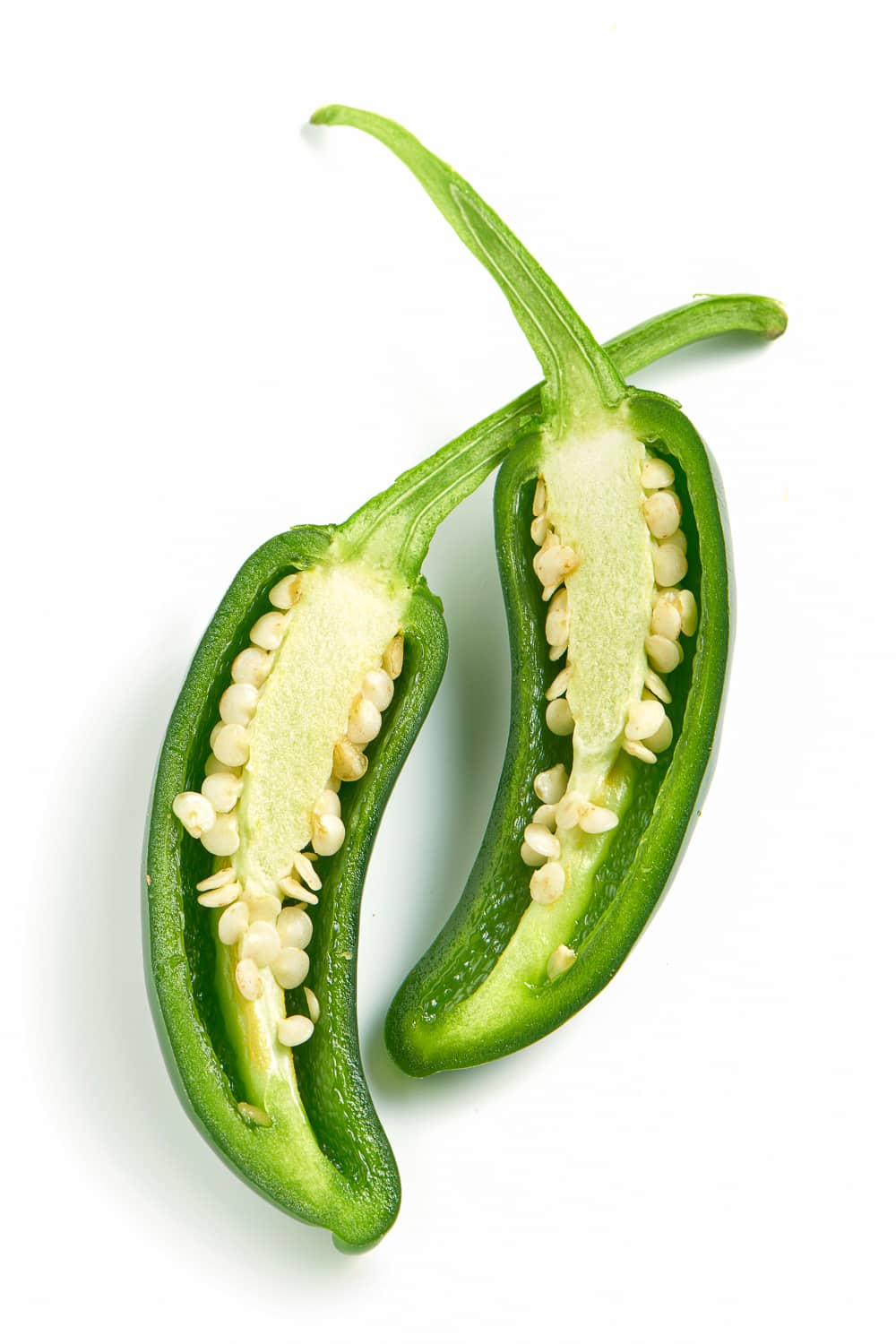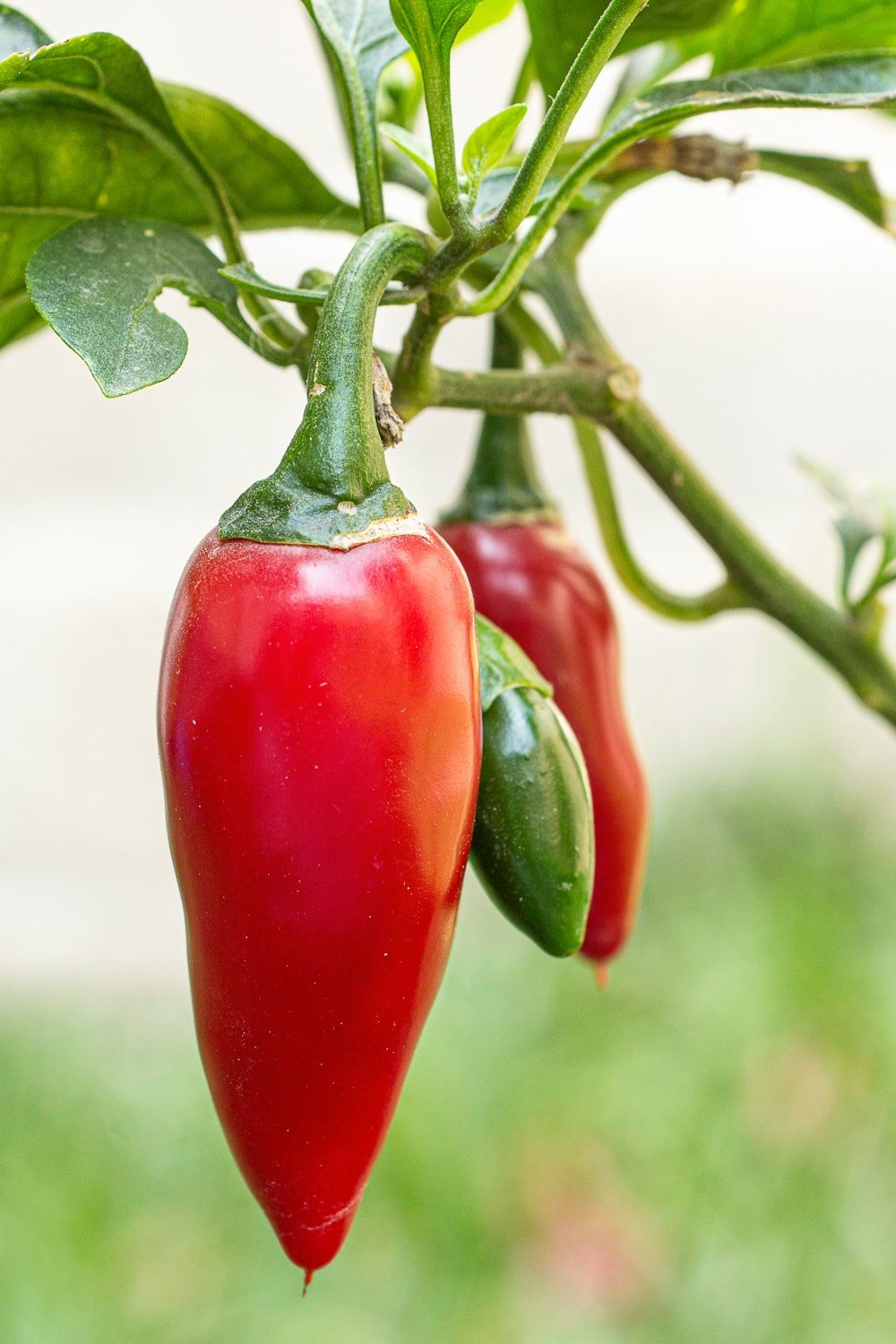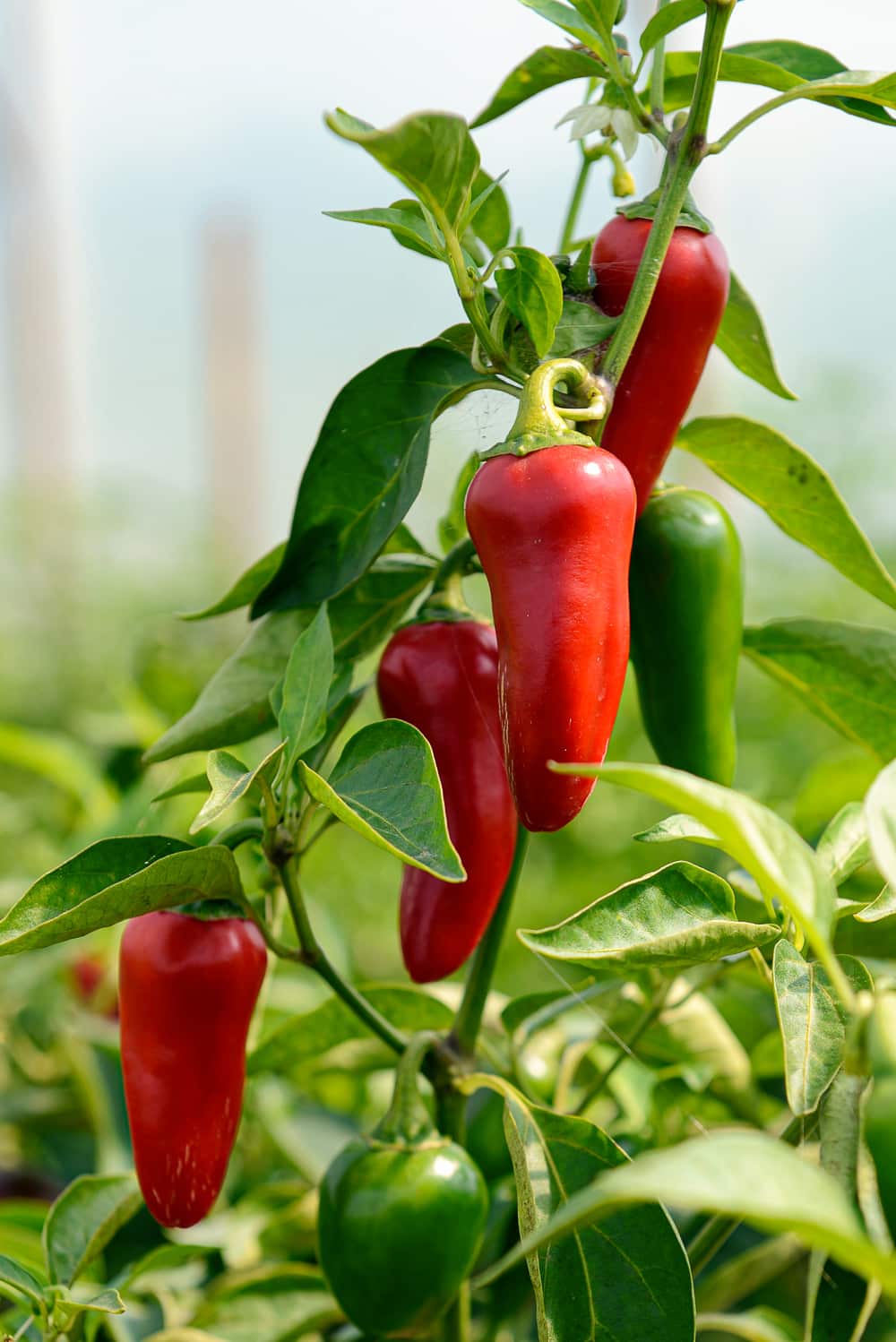Jalapeño Scoville Heat Ranking – How Hot Are Jalapeno Peppers?
Did you get a batch of non-spicy jalapeño peppers? Or did you grow peppers this year that were not as spicy as you thought they would be, or were they too spicy!?
Jalapeno peppers can add a bright, sweet, warm, spicy flavor to dishes. Still, you may be surprised that the jalapeño Scoville ranking is low and that they are one of the mildest hot peppers in the world!
So, how many Scovilles are jalapenos?
Jalapeno peppers rated by heat range from 2000-9000 Scoville heat units, which does sound high. Still, peppers like the Carolina Reaper and Pepper X (the hottest pepper in the world) reach 1,000,000 – 3,000,000+! So you can see why jalapenos are considered mild. And although jalapenos are at the bottom of the heat scale, they can still differ wildly from pepper to pepper in their heat levels.
Read on, and we will explain the jalapeno Scoville scale and why your jalapeno peppers may be too mild or too spicy!

What are Jalapeno Peppers?
Jalapenos are medium-sized chile pepper pod-type cultivars of the species Capsicum annuum.
A mature jalapeño chile pepper is 2-4 inches long and hangs down with a round, firm, smooth glossy flesh 1 – 1.5 inches wide.
Most jalapenos are picked while still green, but if you leave the jalapeno pepper on the plant long enough, it will turn red. Red ripe jalapenos tend to be sweeter and slightly spicier than when green.

Jalapeño Scoville Scale Ranking Ranges from 2000 to 8000 Scoville Heat Units
What’s the Scoville of a jalapeno?
Jalapeño Scoville rankings usually fall from 2000 to 8000 Scoville Units (SHU). By comparison, cayenne peppers rank 30k-50k, and bell peppers rank just 0-200. One of the hottest peppers in the world, Pepper X is 3.18 million – that’s super hot!
The jalapeno Scoville unit measurement ranges from 2000 to 8000, a very similar rating to the wasabi Scoville scale measurement.
What is the Scoville Scale?
Wilbur Scoville invented the Scoville Scale in 1912 to determine the heat level in hot peppers and hot sauce. The test measures the level of heat from extremely mild to extremely hot. You can find all peppers ranked on the Scoville scale.
Scoville Pepper Heat Index
- Mild (100 to 2,500)
- Medium (2,500 to 30,000)
- Hot (30,000 to 100,000)
- Extra Hot (100,000 to 300,000)
- Extremely Hot (above 300,000)

Scoville Scale Heat Units: What are They?
A Scoville heat unit, also known as SHU, is simply a measurement of the number of times capsaicin needs to be diluted by sugar water. The number of SHU in peppers indicates the level of capsaicin. Therefore, the higher the Scoville heat rating, the hotter the pepper.
How are Scoville Units Determined?
For this testing method, ground-up peppers are mixed with sugar-water into a solution that was then given to a panel of taste testers. Next, the peppers were diluted with more sugar water until the mixture was no longer spicy to the tasting panel. Peppers were then assigned a heat level based on the number of dilutions needed to absolve the spiciness. These values are called Scoville Heat Units – or SHUs.
For example, if hot pepper rates at 10,000 Scoville Heat Units, the oil obtained from the extract must be diluted 10,000 times before the heat is detectable.
This is how the jalapeno Scoville level is measured, so even when you think you have a super spicy jalapeno, it’s still considered mild on the chart.

Is the Scoville Scale Accurate or Just a Guideline?
Human tastebuds are different from person to person, making the Scoville scale test somewhat subjective. Scoville ratings for peppers also change according to a type of pepper’s growing conditions like humidity and soil and the pepper’s maturity, seed lineage, and other factors making testing somewhat inaccurate.
Taste testers are also far too subjective to determine an accurate SHU number for most peppers. This is because each tester’s existing spice tolerance is different, and their spice tolerance will increase over extended testing periods.
Since the 1980s, measurement of heat has been performed by high-performance liquid chromatography (HPLC). HPLC measures the concentration of heat-producing capsaicinoids, typically with capsaicin content as the primary measure.
So Then, Why Do Jalapeño Pepper Heat Levels Sometimes Seem to Vary?
There are several reasons why jalapeno peppers can vary in their heat levels:
Jalapeno varieties can have wide variances in heat levels
If you are growing jalapeños at home, consider planting varieties that suit your level of capsaicin tolerance.
Types of mild jalapenos:
- Tam (mild) Jalapeño: 1,000 units
- Big Jim Jalapeño: 2,000-4,000 units
- Espanola Improved: 3,500-4,500 units
- Early Jalapeño: 3,500–5,000
- Senorita Jalapeño: 500
Types of hot jalapenos peppers :
- Mucho Nacho Jalapeño: 5,000-6,500 units
- Rome Jalapeño: 6,000-9,000 units

Seeds from Last year’s Crop may have cross-pollinated
Cross-pollination may also be a factor in creating jalapeño peppers that are too mild. When pepper plants are too close, cross-pollination may occur and subsequently alter the heat level of each particular plant for the next generation. As a result, you can end up with mild jalapenos the following year if you collect seeds from the cross-pollinated pepper.
To avoid cross-pollination, plant your pepper plants at least 6 feet apart.
To reiterate, this season’s pepper plants will not be affected by cross-pollination; only the seeds and subsequent generations of pepper plants planted from cross-pollinated seeds will be impacted.
Too Much Water During Growing Season
If you want hotter jalapenos, cut back on water during the growing season.
The ingredient in peppers that gives them that punch of spice is capsaicin. Capsaicin is the pepper’s natural defense when jalapeño plants are stressed; when they lack water, the capsaicin increases, resulting in hot peppers.
Not Ripe Enough
Is there a difference in heat levels with red vs. green jalapeno peppers?
Yes, green and red jalapeno peppers can vary quite a bit in heat level. If you want hotter peppers, let them ripen until they turn bright red, orange, or yellow (depending on the varieties). Ripe red jalapeño peppers are often sweeter and a touch hotter.

Too Much Nitrogen Fertilizer
Too much nitrogen will create lush green leafy plants at the expense of fruit development. Nitrogen is essential early on, but as the plant grows, it is best to pull back on the nitrogen additions.
- Learn More: See our complete guide on fertilizing pepper plants from seed to fruit for your best harvest.
Additional Tips to Make Your Peppers Hotter!
Add Epsom salt to the soil — Add 1-2 tablespoons of Epsom salt around the base of the pepper plant during planting.
Add sulfur – Chili pepper plants also appreciate an amount of sulfur in the soil, which tends to lead to hotter peppers. Some gardeners who buy sets of pepper plants toss a few unlit matches into the hole before putting the plant in.
And Lastly, Be sure Plant Your Peppers In Slightly Acidic Soil
Do hot peppers like acidic or alkaline soil?
Soil pH is an important consideration when growing hot peppers. The best soil pH for hot peppers will vary depending on the variety of pepper you’re growing and the local climate. Hot peppers do best in slightly acidic soil with a range of pH levels between 6.0 to 7.0.

Be Safe While Cutting Jalapenos
Like all hot peppers, jalapenos may hurt the eyes, nose, mouth, and skin, so be careful about getting the oils on your skin. In addition, it’s a good idea to wear gloves and eye protection. A juicy pepper can splash into your eye and cause significant discomfort.
I cannot tell you how often I have cut hot peppers and touched my eye. I know, you think you’re not going to do it, and then you do it. Not fun!
How to Treat Hot Pepper burns
If you get an uncomfortable pepper burn, here are a few homemade treatments we have tried that work.
- Oil – Use oil like olive oil to rub your hands. Oil will help dissolve oil and help remove the hot pepper oil from your skin.
- Dish Soap – A heavy degreasing dish soap like dawn will help dissolve and remove the burn from your skin.
- Alcohol – Rubbing alcohol or even a dash of hard alcohol can help dissolve the oils and make them easier to wipe from your skin.
- Baking Soda Paste– we have a lot of luck with the baking soda paste method. Make a paste of baking soda and water, rub it over the burn, and let it dry. Once dry, gently wash off with cool water. The cool paste helps ease the burn, and the oils usually come after one application. If your skin is still burning, make another application.
Do not apply any of these remedies to your eyes. If you get jalapeno in your eye, the only home remedy is to flush with cold, clean water. If pain persists, consult an eye doctor.
What can you do with jalapeno peppers?
Chili peppers can easily be used in various ways, not just for their incredibly delicious heat. It works great with other fruits and vegetables, and you may substitute jalapeno wherever you can use bell pepper. Try it in salads, fresh salsas, and sandwiches.
Make stuffed jalapeños by stuffing raw jalapeño with cream cheese and wrapping them in bacon. Toss on the BBQ until the bacon is cooked and you will have the best-tasting jalapeno poppers.
Here are some of our favorite ways to use jalapenos:
- Pickled jalapeño peppers (SO good on everything!)
- Dehydrated Jalapeño peppers plus how to make chipotle peppers right at home (smoked dried peppers)
- Candied jalapeno peppers
- Have Too Many Jalapeños? Here’s What To Do With Extra Jalapeños!
Learn More: If you want to learn more about jalapeno Scoville ratings, chili pepper heat, Caspian, or finding out what is the hottest chili pepper, check out the chile pepper institute.

See more canning and food storage posts
- Canning Beets – Pickled, Spiced, and Easy!
- Easy Peach Preserves Recipe for Canning – No Pectin Required
- How To Make Perfectly Crunchy Homemade Dill Pickles
- How to Make the Most Amazing Rhubarb Jam Without Sugar
- Easy Quick Pickled Red Onions Recipe
- How to Freeze Green Beans To Preserve Texture and Flavor!

Fresno chiles are a similar, but distinct, pepper to jalapenos. They have thinner walls and take less time to mature. The spiciness of a Fresno chile vs jalapeno is often a bit lower.
The spicy part of jalapeno peppers is the seeds, and the area closest to them. The tip of the pepper is the mildest. The easiest way to reduce your jalapeno hotness is to remove the seeds before cooking with them.
Serranos ususally fall somewhere between 10,000 to 23,000 on the Scoville scale, quite a bit hotter than the 2500 to 5000 for jalapenos.
Jalapenos are quite mild compared to other peppers. The pepper with the highest Scoville rating is the Carolina reaper, with a rating of up to 2 million Scoville units, making the jalapenos rating of under 10,000 seem insignificant.
Jalapeno vs ghost pepper and jalapeno vs habanero Scoville comparisons fare about the same, with the ghost pepper registering 1 million, and the habanero around 200,000.
For more info, check out this hot pepper ranking list.




